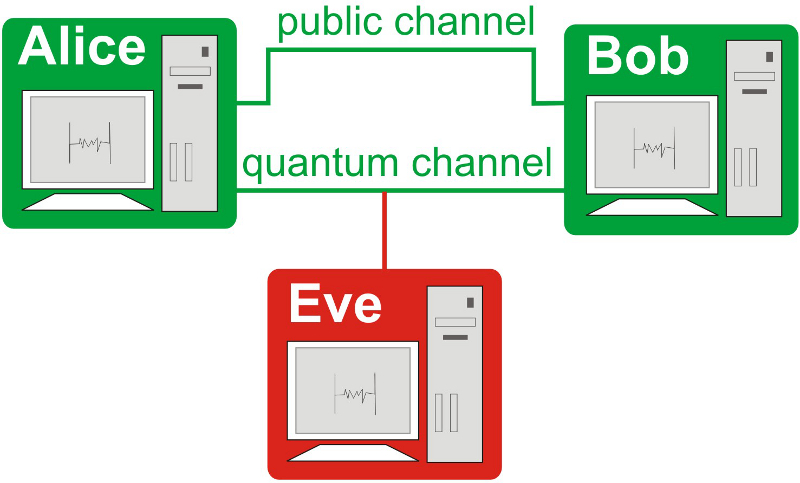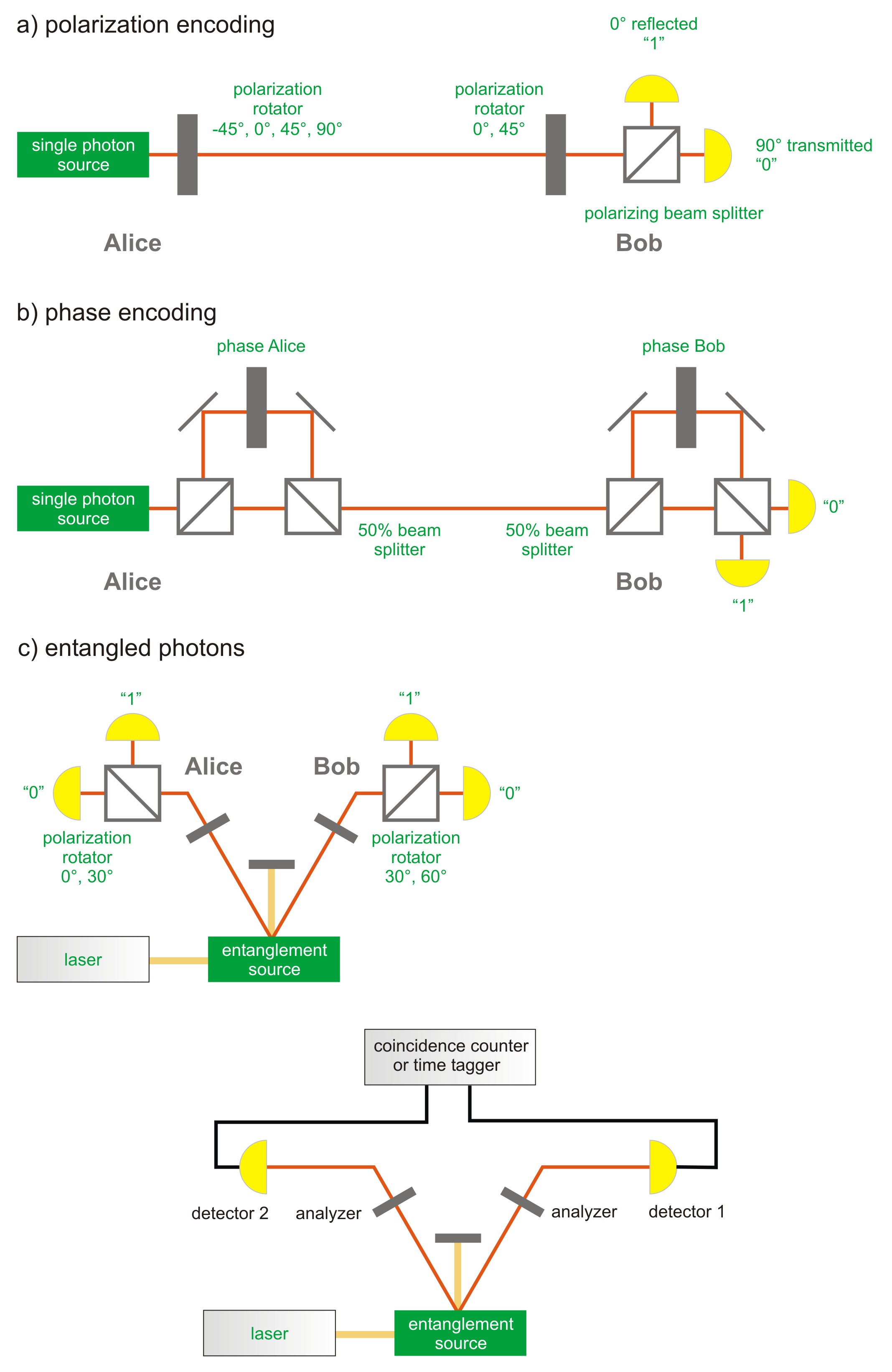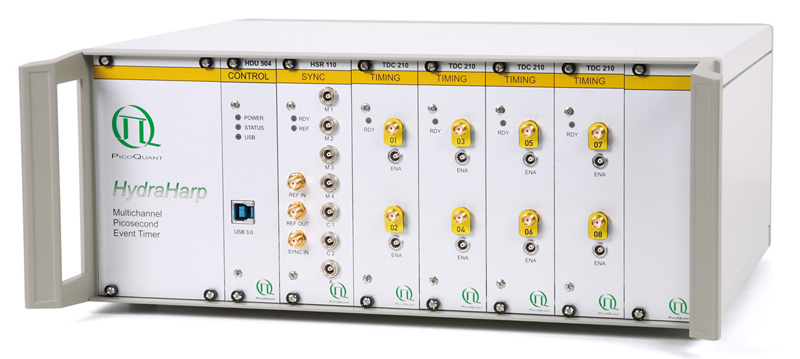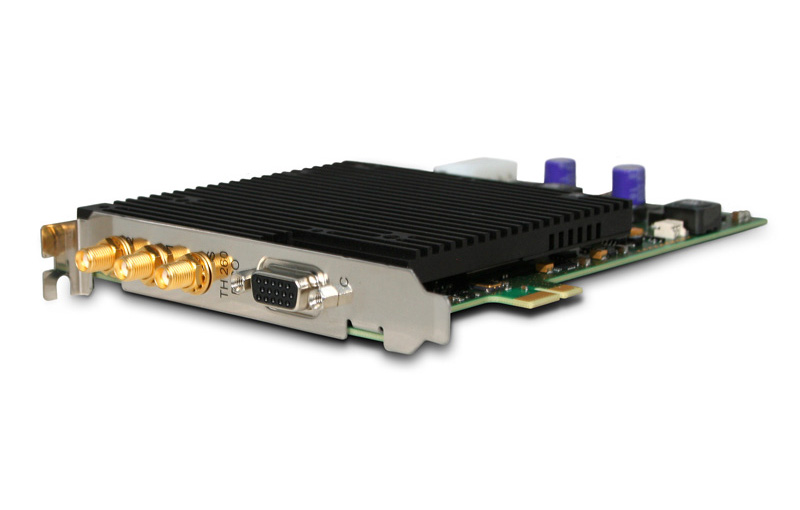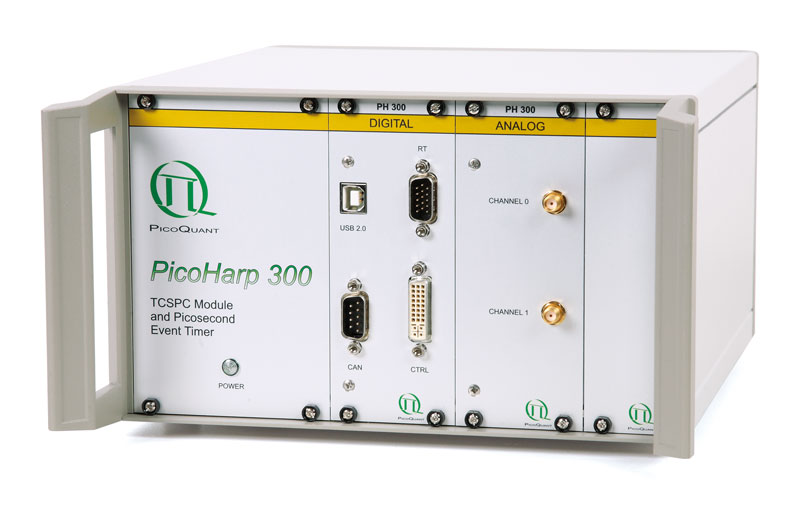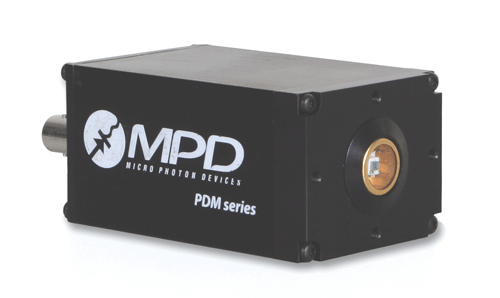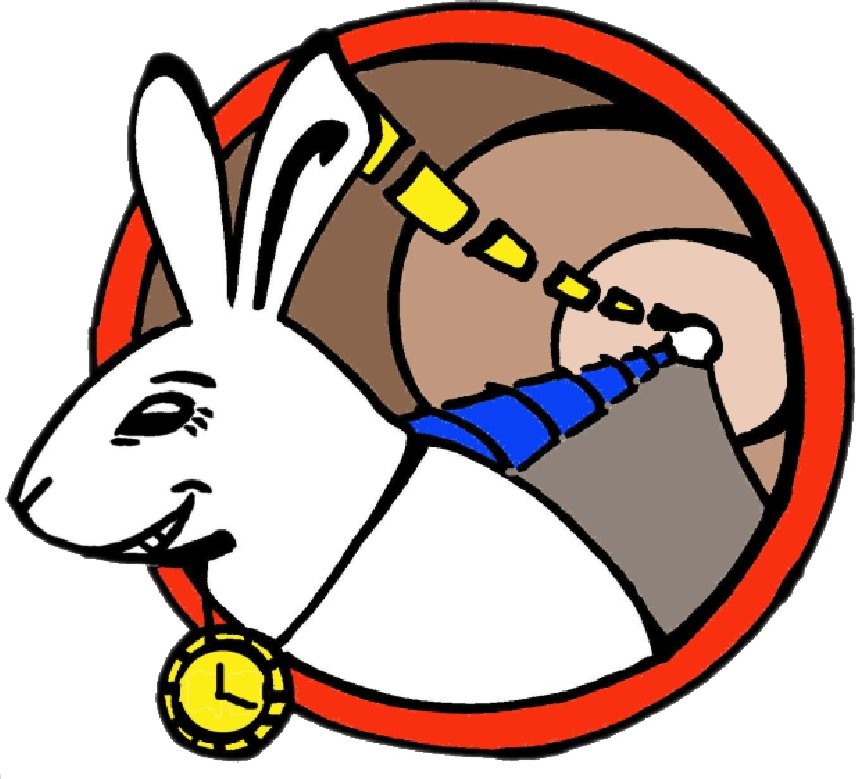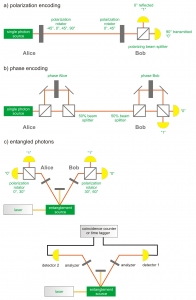 In a typical QKD set-up, the photons are generated by a single photon source, encoded into binary values (i.e., representing "0" and "1") and then transmitted to the receiver either via optical fibers or in free space. The receiver then decodes the state of photons and detects them using single photon sensitive detectors and time-tagging electronics. There are several methods for encoding and decoding the photons:
In a typical QKD set-up, the photons are generated by a single photon source, encoded into binary values (i.e., representing "0" and "1") and then transmitted to the receiver either via optical fibers or in free space. The receiver then decodes the state of photons and detects them using single photon sensitive detectors and time-tagging electronics. There are several methods for encoding and decoding the photons:
- via polarization: the binary information "1" or "0" is defined by the polarization of the single photons, e.g., binary "0" correlates with the horizontally polarized photon and binary "1" with vertically polarized photon
- via the phase, which requires the use of a interferometer system: the phase difference Δφ = φAlice - φBob of the two interferometers is then used for encoding the binary values, e.g., a phase difference Δφ=0 correlates with the binary "0" and the phase difference Δφ=π correlates with the binary "1"
- via entangled photons, which requires one sender of entangled photon pairs and two receivers (Alice and Bob) each equipped with a polarizer. Alice and Bob set the two angles at their respective polarization rotator randomly. If the angles of Alice and Bob match, both photons behave exactly the same at the beam splitter, i.e., they are either transmitted (binary "1") or reflected (binary "0").
Multiple Device Synchonization over White Rabbit
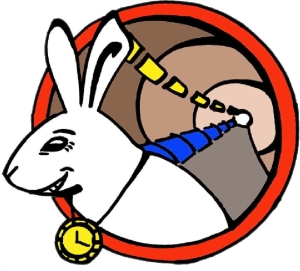 Precise clock synchronization of multiple time taggers via White rabbit is of great value in QKD scenarios in quantum networks. Therefore, our Python interface snAPI allows you to easily implement White Rabbit into your experiments, enabling the simultaneous measurement initiation of two devices with predefinable measurement times. This ensures precise and reliable data acquisition, further streamlining synchronization capabilities across various applications with our MultiHarp 150 and MultiHarp 160 devices.
Precise clock synchronization of multiple time taggers via White rabbit is of great value in QKD scenarios in quantum networks. Therefore, our Python interface snAPI allows you to easily implement White Rabbit into your experiments, enabling the simultaneous measurement initiation of two devices with predefinable measurement times. This ensures precise and reliable data acquisition, further streamlining synchronization capabilities across various applications with our MultiHarp 150 and MultiHarp 160 devices.
Read our application note to learn more: TCSPC Multi-Device Synchronization using MultiHarp and White Rabbit
PicoQuant offers several instruments such as time-tagging units and single photon sensitive detectors that can be used to build a quantum key distribution system:
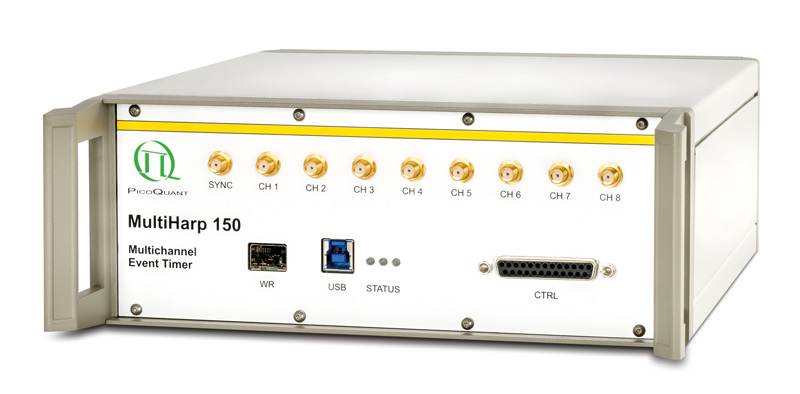 MultiHarp 150
MultiHarp 150
High-Throughput Multichannel Event Timer & TCSPC Unit
- 4, 8, or 16 independent input channels and common sync channel (up to 1.2 GHz)
- High sustained data throughput (80 Mcps in time tagging mode, 180 Mcps in histogramming mode)
- Record-breaking dead time (650 ps) per channel
- No dead time across channels
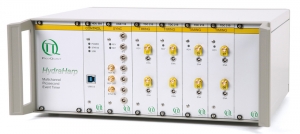 HydraHarp 400
HydraHarp 400
Multichannel Picosecond Event Timer & TCSPC Module
- Up to 8 independent input channels and common synch channel (up to 150 MHz)
- Time channel width of 1 ps
- Time tagging with sustained count rates up to 40 Mcps
- USB 3.0 connection
 PicoHarp 330
PicoHarp 330
Precise and Versatile Event Timer & TCSPC Unit
- Outstanding timing precision of 2 ps RMS for single channel, 3 ps RMS between channels
- Cutting-edge time resolution of 1 ps
- Choice of edge triggers or Constant Fraction Discriminators (CFD)
- Sustained time tagging with up to 85 Mcps via USB 3.0
tion
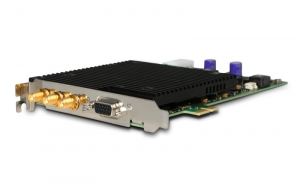 TimeHarp 260
TimeHarp 260
TCSPC and MCS board with PCIe interface
- One or two independent input channels and common synch channel (up to 84 MHz)
- Two models with either 25 ps (PICO model) or 1 ns (NANO model) base resolution
- Ultra short dead time (< 25 ns for PICO model, < 1 ns for NANO model)
- PCIe interface
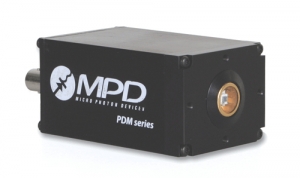 PDM Series
PDM Series
Single Photon Avalanche Diodes
- Timing resolution down to < 50 ps (FWHM)
- Detection efficiency up to 49%
- Different active areas: 20, 50, and 100 µm
- Ultra stable at high count rates
QuCoa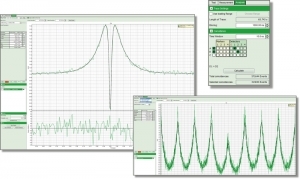
Quantum Correlation Analysis Software
- Antibunching (g(2)) measurements including fitting to several models
- Coincidence counting / event filtering, using AND, OR, NOT operators
- Preview of antibunching curve and correlation data during measurement
- Remote control via TCP/IP Interface
snAPI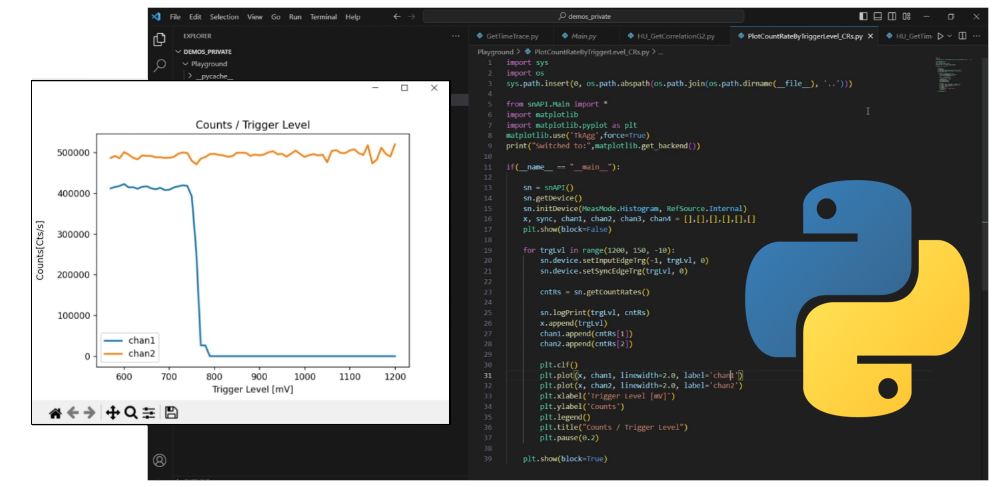
Fast, Intuitive, and Versatile Python Wrapper
- Seamless communication, configuration, and data handling with PicoQuant's TCSPC devices
- Access, manipulate, and process raw data stream, or read from file
- Efficiently handle large photon counts with real-time analysis
- Build your own algorithms, implement complex calculations, and develop tailored data processing pipelines directly in Python
The following presentations are related to quantum communication and were recorded at our International Symposium on "Single Photon based Quantum Technologies" in September 2020.
Latest 10 publications related to Quantum Communication
The following list is an extract of 10 recent publications from our bibliography that either bear reference or are releated to this application and our products in some way. Do you miss your publication? If yes, we will be happy to include it in our bibliography. Please send an e-mail to info@picoquant.com containing the appropriate citation. Thank you very much in advance for your kind co-operation.


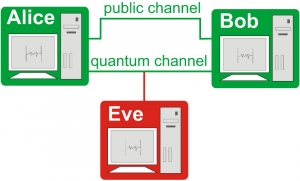
 Contact us
Contact us
 Precise clock synchronization of multiple time taggers via White rabbit is of great value in QKD scenarios in quantum networks. Therefore, our Python interface
Precise clock synchronization of multiple time taggers via White rabbit is of great value in QKD scenarios in quantum networks. Therefore, our Python interface  MultiHarp 150
MultiHarp 150 HydraHarp 400
HydraHarp 400 PicoHarp 330
PicoHarp 330 TimeHarp 260
TimeHarp 260 PDM Series
PDM Series

